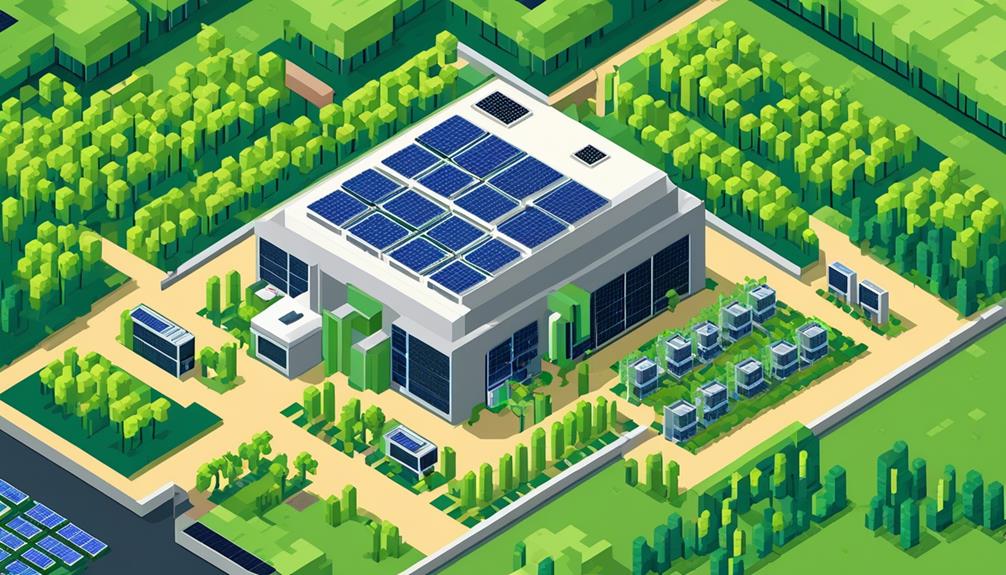As the demand for data storage and processing continues to grow exponentially, the environmental impact of data centers becomes a pressing concern. Green Data Center Technologies offer innovative solutions to address this challenge by optimizing energy efficiency and reducing carbon emissions.
These technologies encompass a range of strategies, from utilizing low-power servers and modular data centers to implementing free air cooling and hot and cold aisle containment. By adopting these practices, organizations can not only achieve significant cost savings but also contribute to their sustainability goals.
In this discussion, we will explore some of these green data center technologies, their benefits, and their potential to revolutionize the way data centers operate.
Key Takeaways
- Low-power servers are an effective solution for reducing energy consumption in data centers and contributing to environmental sustainability.
- Modular data centers offer scalability, flexibility, and cost-effectiveness, while incorporating energy-efficient technologies and cooling systems.
- Energy efficiency measures, such as incorporating low-power servers and innovative cooling systems, optimize resource consumption in data centers.
- Reusing waste heat from data centers through technologies like heat exchangers or district heating systems reduces reliance on traditional heating methods and promotes energy savings.
Low-Power Servers
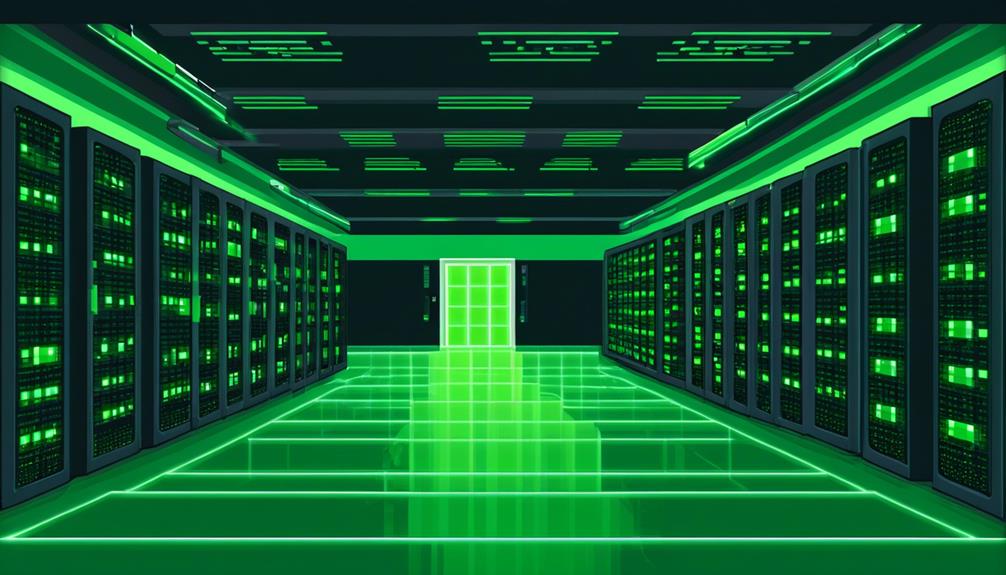
Low-power servers, known for their energy efficiency, play a crucial role in reducing energy consumption and environmental impact in data centers. These servers are designed to optimize energy efficiency, making them an essential component of green data centers.
By adopting low-power servers, data centers can significantly minimize their energy consumption. Traditional servers consume a substantial amount of power, leading to high energy costs and increased carbon emissions. In contrast, low-power servers are specifically engineered to operate using minimal energy, resulting in reduced energy consumption and lower operating costs.
The use of low-power servers also contributes to the overall environmental sustainability of data centers. As organizations strive to adopt more sustainable practices, minimizing the environmental impact of data centers becomes paramount. By using energy-efficient low-power servers, data centers can reduce their carbon footprint and minimize their reliance on non-renewable energy sources.
Furthermore, implementing low-power servers can lead to significant cost savings for organizations. By reducing energy consumption, data centers can lower their electricity bills, resulting in substantial financial benefits. These cost savings can then be reinvested into other areas, such as improving infrastructure or adopting additional green technologies.
Modular Data Centers
Modular data centers offer several benefits to organizations, including modularity, scalability, and flexibility.
With standardized components that can be easily assembled, these data centers provide a cost-effective and efficient solution for expanding data center capacity.
Additionally, modular data centers incorporate energy-efficient technologies and cooling systems, helping to reduce energy consumption and minimize environmental impact.
Benefits of Modularity
The flexibility and scalability offered by modular data centers make them a highly efficient and adaptable solution for evolving data center needs. These sustainable data centers can be rapidly deployed and are pre-engineered for quick setup, reducing time to market and providing a cost-effective solution.
Modular data centers enhance energy efficiency by incorporating advanced cooling and power distribution systems, resulting in lower operating costs. They also optimize resource usage and minimize waste, aligning with green data center practices.
Additionally, their portable nature and standardized design make maintenance, upgrades, and relocations easier, ensuring a more adaptable and resilient data center infrastructure.
Scalability and Flexibility
With the ability to easily adapt and expand data center capacity based on specific needs, modular data centers offer unparalleled scalability and flexibility for organizations seeking efficient and agile solutions. These data centers provide the capability to quickly deploy additional IT infrastructure, reducing time to market and enhancing agility.
The modular design of data centers allows for efficient use of resources and the ability to scale up or down as demand fluctuates. This scalability ensures that organizations can optimize their IT infrastructure based on evolving needs and growth.
Furthermore, the flexibility of modular data centers allows for easy customization and adaptation to changing technology and business requirements, ensuring long-term viability. By incorporating green technologies, these data centers can also reduce energy consumption and minimize their environmental impact.
Energy Efficiency Measures
Energy efficiency measures in modular data centers encompass the utilization of low-power servers and innovative cooling systems to optimize resource consumption and promote sustainability. These data centers are designed for rapid deployment and portability, incorporating efficient storage technology and hot/cold aisle containment for optimized cooling and airflow. Evaporative cooling technologies, waste heat recovery, and ultrasonic humidification are employed to enhance energy efficiency.
Green data centers, including modular designs, can achieve LEED and Energy Star certifications, validating their energy efficiency and environmental friendliness. Investing in energy-efficient modular data centers can lead to long-term cost savings, reduced environmental impact, and potential returns on investment in sustainable technology.
Free Air Cooling
Utilizing outdoor air to cool data centers in cooler climates, free air cooling is a crucial technology for improving energy efficiency and reducing carbon emissions in green data centers.
- Energy savings: Free air cooling takes advantage of the lower temperatures in outdoor air, eliminating the need for mechanical cooling systems. By using outdoor air as a natural coolant, data centers can significantly reduce their energy consumption and associated costs.
- Proper air filtration and humidity control: To ensure the reliability and effectiveness of free air cooling, data centers need to implement proper air filtration systems. This helps prevent the introduction of contaminants and particulate matter that could damage sensitive equipment. Additionally, humidity control is essential to maintain optimal operating conditions for the servers and infrastructure.
- Regional suitability: Free air cooling is particularly effective in regions with cooler climates. In these areas, the outdoor air temperature remains within the acceptable range for data center operation throughout the year. By leveraging the natural cooling potential of the environment, data centers can achieve high levels of energy efficiency and reduce their reliance on traditional cooling methods.
Implementing free air cooling in data centers is a key step towards a more sustainable IT infrastructure. By harnessing the power of outdoor air, data centers can significantly reduce their carbon emissions and contribute to a greener environment. However, it is important to note that free air cooling may not be suitable for all climates or situations. Factors such as air quality, humidity levels, and equipment requirements need to be carefully considered when implementing this technology.
Hot and Cold Aisle Containment
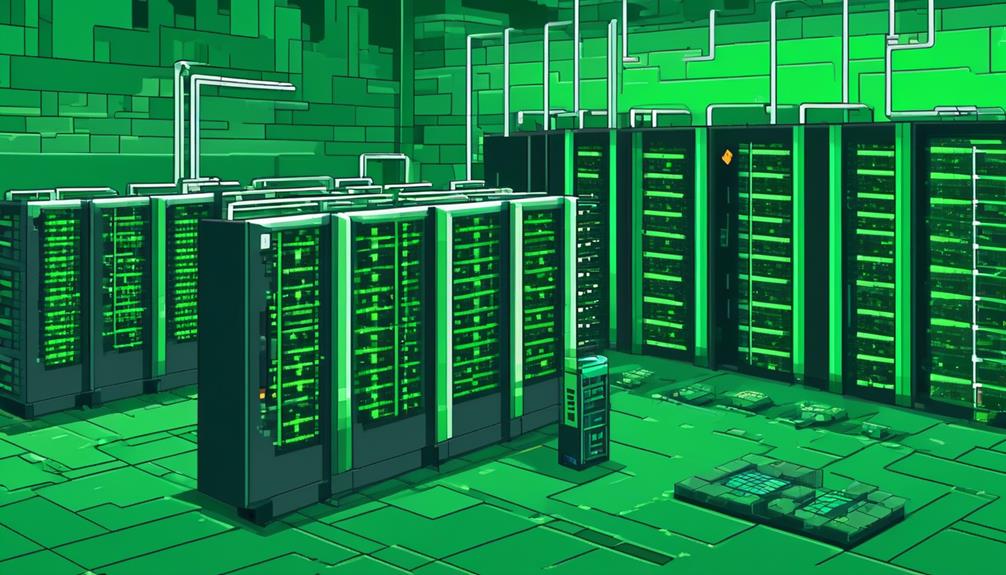
To further enhance cooling efficiency and maximize energy savings in green data centers, the implementation of hot and cold aisle containment is essential. Hot and cold aisle containment is a technique used to separate the hot and cold air streams in data centers, preventing mixing and improving cooling effectiveness.
Cold aisle containment involves enclosing the cold aisle to prevent mixing with hot air, while hot aisle containment encloses the hot aisle to prevent mixing with the cold air.
By implementing hot and cold aisle containment, data centers can achieve energy savings of up to 30%. This is because the technique reduces energy waste and improves cooling efficiency, resulting in lower energy consumption.
Compared to traditional cooling technologies, hot and cold aisle containment methods are more effective in reducing energy consumption and improving the overall energy efficiency of data centers.
However, it is important to note that the successful implementation of hot and cold aisle containment requires proper planning and design. Effective separation of hot and cold air streams is crucial to ensure optimal cooling and energy efficiency.
Careful consideration must be given to the layout and arrangement of racks, the placement of vents, and the overall airflow management within the data center.
Reusing Waste Heat
The intelligent reuse of waste heat from data centers contributes to a more sustainable energy ecosystem, benefiting both the environment and other facilities. By harnessing the waste heat generated by data centers, organizations can reduce their environmental impact and promote the efficient use of resources.
Here are three key facts about reusing waste heat from data centers:
- Technologies like heat exchangers or district heating systems enable the intelligent reuse of waste heat from data centers. These technologies allow the captured heat to be transferred to other facilities, such as nearby buildings or industrial processes, where it can be utilized for heating purposes. This approach not only reduces the reliance on traditional heating systems but also minimizes energy waste.
- Reusing waste heat from data centers for heating buildings, water, or industrial processes can contribute to significant energy savings. By utilizing this renewable source of energy, organizations can reduce their reliance on fossil fuels and lower their overall energy consumption. This not only leads to cost savings but also helps to mitigate the environmental impact associated with traditional heating methods.
- Waste heat reuse technologies help data centers achieve greater energy efficiency and reduce their environmental impact. By implementing these technologies, data centers can optimize their operations and minimize energy wastage. This aligns with sustainability goals and promotes a more environmentally friendly approach to data center management.
Ultrasonic Humidification
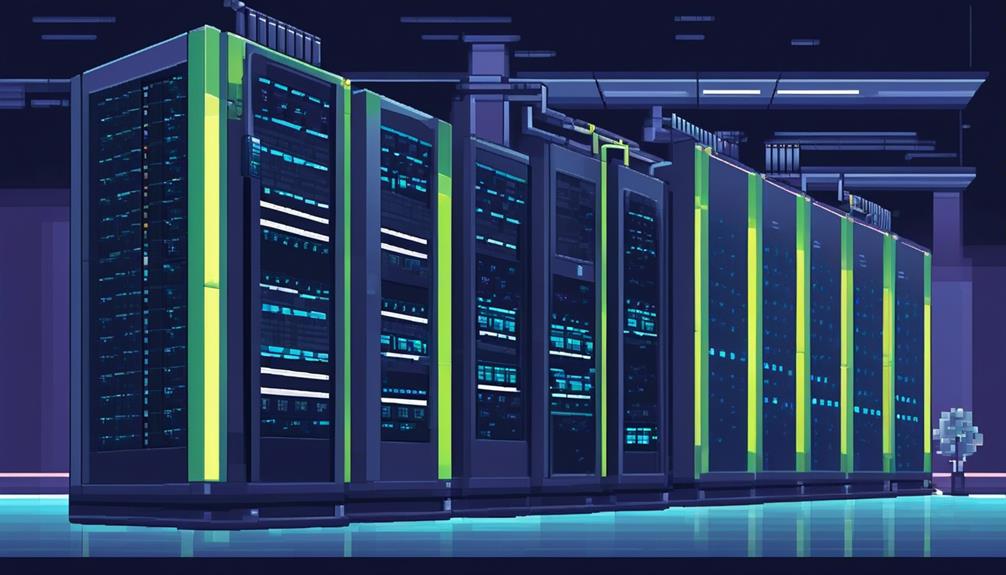
Ultrasonic humidification is an energy-efficient method that utilizes ultrasound to create moisture in data centers. This technology consumes 90% less energy than conventional humidification methods, making it a sustainable and efficient solution for maintaining optimal humidity levels.
Energy-Efficient Humidification
Energy-efficient humidification in data centers can be achieved through the use of ultrasonic technology, which significantly reduces energy consumption while maintaining the required humidity levels. This method utilizes ultrasound to create moisture, making it a sustainable and efficient solution for data centers.
Here are three key benefits of implementing ultrasonic humidification:
- Reduced Energy Consumption: Ultrasonic humidification consumes 90% less energy compared to conventional humidification methods. This energy efficiency contributes to the overall energy efficiency of the data center and aligns with the goal of reducing energy consumption.
- Sustainability: Ultrasonic humidification is a key component of green data centers, emphasizing the use of renewable energy sources and sustainable practices. By adopting this technology, data centers can enhance their sustainability efforts and reduce their environmental impact.
- Maintenance of Required Humidity Levels: Ultrasonic humidification ensures that the data center maintains optimal humidity levels, creating a suitable environment for IT equipment. This helps to prevent equipment damage and improves overall data center performance.
Benefits of Ultrasonic Technology
One notable advantage of implementing ultrasonic technology in data centers is its ability to significantly reduce energy consumption while maintaining optimal humidity levels. Ultrasonic humidification is an energy-efficient method that uses 90% less energy than conventional methods.
By using ultrasonic technology, data centers can maintain the required humidity levels without consuming excessive energy, thereby promoting energy efficiency and environmental responsibility. This technology contributes to reducing the overall energy consumption and environmental impact of data centers, resulting in lower energy costs and a smaller environmental footprint.
Implementing ultrasonic humidification aligns with the goal of achieving greater energy efficiency and sustainability in data center operations. It is an effective solution for reducing resource consumption and promoting a greener approach to data center management.
Evaporative Cooling
Evaporative cooling is a highly efficient and environmentally friendly technique that effectively reduces heat in data centers through the evaporation of water. This method offers energy-efficient cooling solutions and is favored for its cost-effectiveness and sustainability. Here are three key aspects of evaporative cooling in data centers:
- Evaporation pads: Evaporative cooling systems incorporate evaporation pads, also known as cooling pads or wet pads. These pads are made from materials with high water absorption capabilities. As warm air passes through the pads, water evaporates, cooling down the air and reducing its temperature before it enters the data center. This process significantly lowers the heat load without the need for energy-intensive mechanical cooling systems.
- High-pressure systems: Some evaporative cooling solutions use high-pressure misting or fogging systems. These systems create a fine water mist, which quickly evaporates due to the high-pressure environment. The evaporation process absorbs heat from the surrounding air, effectively cooling it down. High-pressure systems offer precise control over temperature and humidity levels, ensuring optimal conditions for data center equipment.
- Data center efficiency: Evaporative cooling technologies contribute to overall data center efficiency by reducing energy consumption. Compared to traditional mechanical cooling systems, evaporative cooling systems consume significantly less electricity. This translates into cost savings and a lower environmental impact. By implementing evaporative cooling, data centers can enhance their energy efficiency and align with sustainability goals, such as those set by the Green Building Council.
Investment in Green Data Center
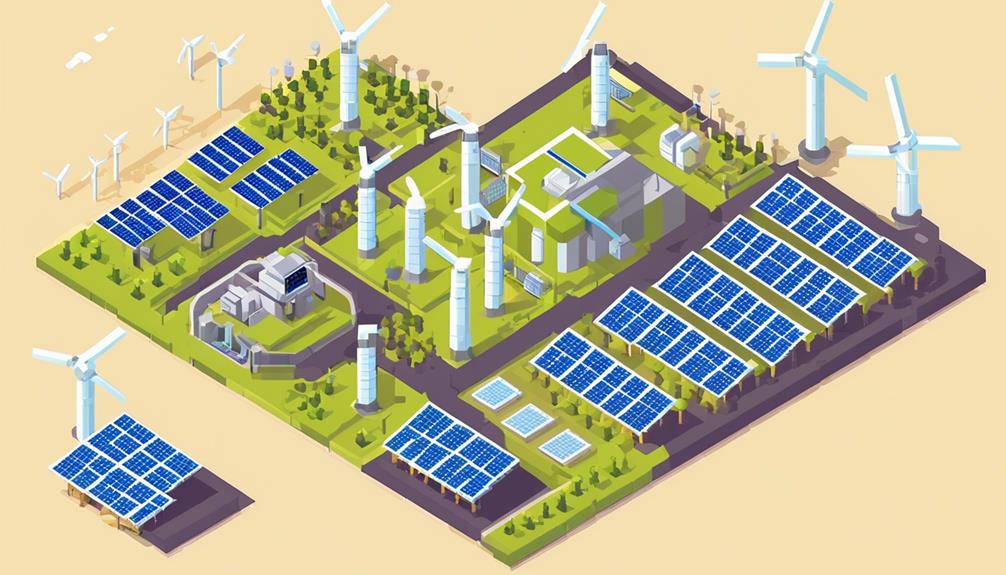
Investment in green data centers presents a strategic opportunity for organizations seeking to optimize their operational efficiency and environmental sustainability. By adopting environmentally responsible technologies, companies can not only reduce their carbon footprint but also achieve long-term cost savings and support a healthy work environment for employees. Additionally, governments are increasingly offering tax incentives and monetary support for organizations that invest in green data centers, further enhancing the financial benefits of such investments. The growing pressure from environmentalists and the general public for governments to promote green initiatives is creating a promising environment for organizations to invest in green data centers.
Green data centers contribute to a more sustainable and environmentally friendly IT infrastructure. This not only attracts environmentally conscious customers and investors but also helps organizations align with their sustainability goals and reduce their environmental impact. By investing in energy-efficient technologies, such as evaporative cooling systems and renewable energy sources, organizations can significantly reduce their energy consumption and overall environmental impact.
To provide a clear overview of the benefits of investing in green data centers, the following table summarizes the advantages associated with this strategic investment:
| Benefits | Description |
|---|---|
| Cost savings | Long-term financial savings through reduced energy consumption and lower maintenance costs. |
| Tax incentives | Governments offer tax incentives and monetary support for using environmentally responsible technologies. |
| Environmental sustainability | Green data centers contribute to a more sustainable and environmentally friendly IT infrastructure. |
| Attracting customers and investors | Environmental consciousness is increasingly valued, attracting customers and investors who prioritize sustainability. |
Investing in green data centers not only offers organizations financial benefits but also contributes to a more sustainable and environmentally conscious future. By optimizing energy usage and adopting eco-friendly technologies, organizations can reduce their environmental impact while achieving long-term operational efficiency.
Energy-Efficient Lighting Solutions
By implementing energy-efficient lighting solutions, organizations can further optimize their operational efficiency and environmental sustainability within green data centers. The use of energy-efficient lighting technologies can significantly reduce data center power consumption and contribute to overall energy efficiency.
Here are three key energy-efficient lighting solutions that can be implemented in data centers:
- LED Lighting: Implementing LED lighting can lead to substantial energy savings in data center facilities. LED lights are more efficient than traditional lighting options, such as incandescent or fluorescent bulbs, as they convert a higher percentage of electricity into light, rather than heat. This not only reduces power consumption but also lowers cooling requirements in the data center.
- Smart Lighting Controls: Incorporating smart lighting controls can further enhance energy efficiency in data centers. These controls use sensors and advanced algorithms to optimize lighting usage based on occupancy and daylight levels. By automatically adjusting light levels and turning off lights in unoccupied areas, smart lighting controls minimize energy waste and contribute to data center efficiency.
- Daylight Harvesting Systems and Occupancy Sensors: Daylight harvesting systems utilize natural light sources to supplement or replace artificial lighting in data centers. By using sensors and controls, these systems adjust artificial lighting levels based on available daylight, reducing the reliance on energy-consuming light fixtures. Occupancy sensors, on the other hand, detect movement in a space and ensure that lights are only activated when needed, further reducing energy consumption.
Implementing these energy-efficient lighting solutions not only reduces operational costs but also aligns with environmental sustainability goals. Organizations can also look for lighting products certified by programs like Energy Star, which ensure high energy efficiency standards.
Virtualization Technology
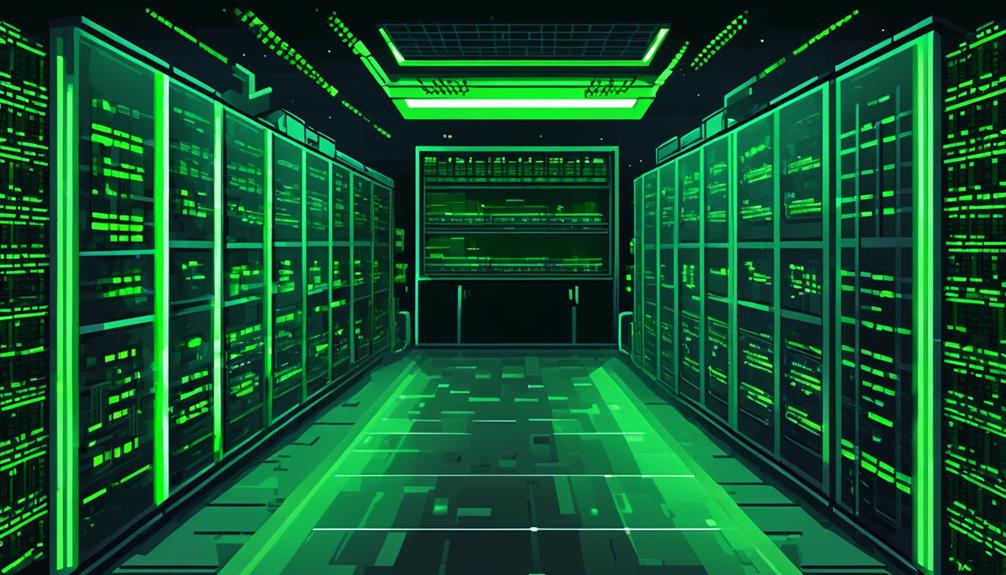
Virtualization technology revolutionizes data center operations by enabling a single physical server to efficiently run multiple virtual machines. This technology optimizes resource utilization, reducing the need for physical hardware and resulting in lower energy consumption and space requirements. By consolidating servers and workloads, virtualization helps cut down on operational costs and hardware maintenance. It also enables dynamic allocation of computing resources, improving overall data center efficiency.
Virtualization offers several benefits that contribute to a greener and more sustainable data center environment. First, it allows for better resource management, as administrators can allocate resources based on demand, minimizing waste and maximizing efficiency. This dynamic resource allocation also enables data centers to scale up or down quickly and easily, responding to changing workload requirements.
Furthermore, virtualization provides disaster recovery and high availability solutions, enhancing data center reliability and resilience. By creating virtual machine snapshots and replicating them across multiple servers, the risk of data loss is significantly reduced. In the event of a server failure, virtual machines can be quickly migrated to another server, ensuring minimal downtime and maintaining business continuity.
To illustrate the impact of virtualization technology, consider the following table:
| Benefit | Description |
|---|---|
| Resource utilization | Optimize resource usage by running multiple virtual machines on a single physical server |
| Energy efficiency | Reduce energy consumption and space requirements by minimizing the need for physical hardware |
| Cost savings | Cut down on operational costs and hardware maintenance by consolidating servers and workloads |
| Scalability | Quickly scale up or down to meet changing workload demands |
| Disaster recovery | Provide high availability and data protection through virtual machine snapshots and replication |
Renewable Energy Integration
Renewable energy integration is a critical aspect of green data center technologies. It involves utilizing energy sources such as solar and wind power, along with battery storage, to sustainably power data centers.
This integration not only helps reduce carbon emissions and environmental impact but also provides cost savings through the use of energy-efficient technologies.
Energy Sources for Data Centers
The integration of renewable energy sources, such as solar and wind power, is a key strategy for reducing reliance on traditional grid power in green data centers. By harnessing these sustainable energy sources, data centers can significantly lower their carbon emissions and promote a more environmentally friendly IT infrastructure.
This integration not only helps in meeting sustainability goals but also leads to substantial cost savings for data center operators. Energy-efficient technologies play a crucial role in achieving these savings by optimizing power consumption and reducing wastage.
Metrics like Power Usage Effectiveness (PUE) and Carbon Usage Effectiveness (CUE) are used to measure and improve energy efficiency in green data centers. Furthermore, certifications like LEED and Energy Star validate the energy efficiency and eco-friendliness of these data centers.
Power Grid Integration
By incorporating renewable energy sources like solar and wind power into the traditional power grid, data centers can optimize their energy consumption and reduce reliance on conventional fossil fuels.
Power grid integration enables the smooth integration of renewable energy, ensuring a balanced and reliable power supply.
Integration technologies facilitate the efficient distribution and utilization of renewable energy within the existing power grid infrastructure. This integration is essential for maximizing the benefits of renewable energy and reducing environmental impact.
For data centers, power grid integration allows them to tap into renewable energy sources, improving their energy efficiency and sustainability.
By relying on renewable energy, data centers can minimize their carbon footprint and contribute to a greener and more sustainable future.
Effective power grid integration is crucial for achieving energy efficiency and reducing the environmental impact of data centers.
Sustainable Energy Solutions
Sustainable energy solutions in data centers integrate renewable energy sources such as solar and wind power, optimizing energy consumption and reducing reliance on conventional fossil fuels. This approach aligns with the growing demand for green data center technologies that prioritize sustainability and reduce environmental impact.
Implementing renewable energy integration in data centers offers several benefits:
- Reduced carbon emissions: By utilizing renewable energy sources, data centers can significantly reduce their carbon footprint and contribute to a more environmentally friendly IT infrastructure.
- Cost savings: Sustainable energy solutions can lead to significant cost savings by reducing reliance on traditional energy sources and taking advantage of the increasingly competitive prices of renewable energy.
- Meeting sustainability goals: Integrating renewable energy into data centers helps organizations meet their sustainability objectives and demonstrate their commitment to environmentally responsible technologies.
Sustainable Cooling Systems
In the pursuit of optimizing energy efficiency and reducing environmental impact, data centers are implementing innovative technologies for their cooling systems. Sustainable cooling systems are designed to minimize energy consumption and utilize various technologies to achieve this goal. Three key technologies commonly used in these systems are free air cooling, hot/cold aisle containment, and waste heat reuse.
Free air cooling involves using outside air to cool the data center instead of relying solely on mechanical cooling systems. By taking advantage of lower outdoor temperatures, data centers can reduce their reliance on energy-intensive cooling equipment, resulting in significant energy savings. This technology is particularly effective in regions with cooler climates.
Hot/cold aisle containment is a technique that involves segregating hot and cold air streams within the data center. By creating a physical barrier between the hot exhaust air and the cold air supply, this approach prevents the mixing of airflows and optimizes cooling efficiency. This results in reduced energy consumption and improved overall performance of the cooling system.
Waste heat reuse is another innovative technology used in sustainable cooling systems. Instead of allowing the waste heat generated by the data center to go to waste, it is captured and repurposed for other applications. For example, the waste heat can be used to heat nearby buildings or generate electricity, further enhancing the energy efficiency of the data center.
Implementing these sustainable cooling technologies not only contributes to significant cost savings for data centers but also helps organizations achieve their sustainability goals. By reducing energy consumption and carbon emissions, data centers can promote a more sustainable and environmentally friendly IT infrastructure. Moreover, adopting green cooling technologies enhances a company's reputation as an environmentally responsible organization.
The following table highlights the benefits and advantages of sustainable cooling systems:
| Technology | Benefits |
|---|---|
| Free Air Cooling | – Significant energy savings |
| – Reduced reliance on mechanical cooling | |
| equipment | |
| Hot/Cold Aisle | – Improved cooling efficiency |
| Containment | – Reduced energy consumption |
| – Enhanced overall performance | |
| Waste Heat Reuse | – Repurposing waste heat for other |
| applications | |
| – Further enhancing energy efficiency |
Frequently Asked Questions
What Is a Green Data Center?
A green data center refers to an energy-efficient facility that utilizes sustainable infrastructure and renewable energy sources. These centers are designed to minimize environmental impact and maximize energy efficiency. They employ advanced technologies and strategies to reduce energy consumption and carbon emissions.
What Are General Practice for Green Data Centres?
Energy efficient design, renewable energy sources, and sustainable cooling solutions are general practices for green data centers. These practices aim to maximize energy efficiency, minimize environmental impact, and promote long-term sustainability.
Energy efficient design involves utilizing technologies such as efficient storage, low-power servers, and modular data center setups.
Renewable energy sources, such as solar or wind power, contribute to a more sustainable IT infrastructure.
Sustainable cooling solutions, such as evaporative cooling and waste heat recovery, help reduce energy consumption and minimize environmental impact.
How to Build a Green Data Center?
To build a green data center, it is crucial to focus on energy efficient design, sustainable infrastructure, and the use of renewable energy sources.
By implementing advanced technologies and strategies, such as minimized building footprints and low-emission building materials, data centers can maximize energy efficiency and minimize environmental impact.
Additionally, incorporating renewable energy sources like solar and wind power, along with efficient storage technology and modular data centers, can further optimize energy usage and reduce reliance on traditional energy sources.
What Is the Demand for Green Data Centers?
The demand for green data centers is driven by the need for renewable energy sources, carbon footprint reduction, and energy efficient infrastructure. Companies are seeking these data centers to reduce operating costs, meet sustainability goals, and attract environmentally conscious customers and investors.
The rising demand is fueled by increasing pressure from environmentalists and the public, as well as potential tax incentives. Green data centers contribute to a more sustainable future by reducing energy consumption and carbon emissions.

